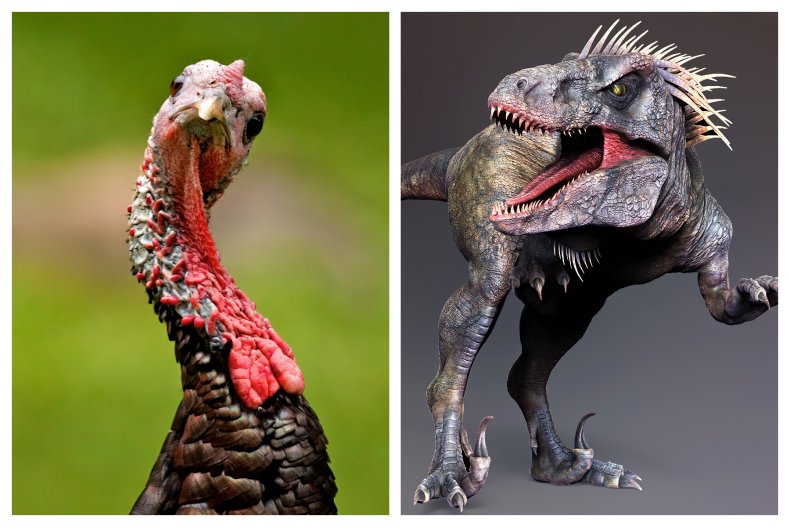BY JESS THOMSON
Update 11/08/2022
A fossil that was discovered in 1933 has finally been identified as a new species.
The fossil had sat unidentified in a museum for 89 years before it was officially confirmed to be a new species of turkey-like dinosaur named Centuriavis lioae, according to a paper published in the Journal of Paleontology.
Daniel Ksepka, curator of the Bruce Museum in Greenwich, Connecticut, and Kate Dzikiewicz, curatorial associate, led a study of the fossil, in which they used CT scans to reconstruct the shape of the brain and analyzed skeletal features to place the fossil in the evolutionary tree of birds.
The species was named in honor of Suzanne Lio, the managing director and chief operating officer at the Bruce Museum.
A fossil that was discovered in 1933 has finally been identified as a new species.
The fossil had sat unidentified in a museum for 89 years before it was officially confirmed to be a new species of turkey-like dinosaur named Centuriavis lioae, according to a paper published in the Journal of Paleontology.
Daniel Ksepka, curator of the Bruce Museum in Greenwich, Connecticut, and Kate Dzikiewicz, curatorial associate, led a study of the fossil, in which they used CT scans to reconstruct the shape of the brain and analyzed skeletal features to place the fossil in the evolutionary tree of birds.
The species was named in honor of Suzanne Lio, the managing director and chief operating officer at the Bruce Museum.
"I'm so thankful to have even been considered for this honor," Lio said in a statement. "I'm truly blessed to work for the Bruce Museum where I'm surrounded by such an incredible, dedicated team of employees. This is really a celebration for all of us at the Bruce."
Centuriavis lioae is thought to have lived around 11 million years ago, and is a distant relative of modern day turkeys and grouse. The fossil was first discovered in 1933 in Nebraska, but hadn't been examined until now. Having lived long after the Cretaceous extinction event caused by an asteroid impact around 66 million years ago, this species only has some of the characteristics of a traditional dinosaur.

A file photo of a turkey (left) and a raptor dinosaur with feathers (right). A turkey-like dinosaur fossil was identified as a new species after laying in museum archives for nearly 100 years.
"I love that it's being called a dinosaur by everyone. That is 100% accurate, but it's also a bird, related to today's grouse and turkeys. The specimen is beautifully preserved and shows that Centuriavis was about the size of a sage grouse, which is about half the size of a big farm chicken. If it was like its relatives, it was probably a social and beautiful member of the developing grasslands of North America," Ashley Poust, a paleontology researcher at San Diego Natural History Museum, told Newsweek.
This surprisingly long period of time between discovery and identification is not uncommon in the field.
"Museums often contain hundreds of thousands or millions of specimens, and these have been collected over the last 100 years or more. Often paleontologists or biologists come back from an expedition into new territory with huge collections of specimens, and can take literally years or decades to sort out, clean up, identify and catalog everything," Mike Benton, a professor of vertebrate paleontology at the University of Bristol, told Newsweek.
"With fossils, the specimens may be enclosed in the rock, and it can sometimes take an expert fossil preparator (a technician) many weeks or months to do the painstaking work to remove rock attached to a delicate skeleton before it is ready for study or exhibit."
Additionally, newer technologies like DNA sequencing may result in the identification of newer species long after their arrival at a museum.
"Museum collections contain millions of specimens of fossil and living organisms but there are not enough scientists to study every single one; they are like an immense library where many of the books have not been fully read. So scrutiny of museum collections can yield fantastic new discoveries.
"One important new development is DNA technology—all major museums hold collections of DNA as well as physical specimens. Often, analysis of this DNA reveals what we formerly thought were a single species is actually a complex of several 'cryptic species' which are very similar, but reproductively isolated and genetically distinct," Michael Lee, a professor of evolutionary biology at Flinders University, told Newsweek.
This may mean that specimens buried in museum archives across the globe could eventually find themselves identified as new species with the advance of technology.
"It makes me excited to think about all of the studies that will happen in the future, when new technologies that we can scarcely imagine today are brought to bear on fossils and other objects that museums have been patiently securing for decades," Steve Brusatte, a vertebrate paleontologist and evolutionary biologist at the University of Edinburgh, told Newsweek.
No comments:
Post a Comment